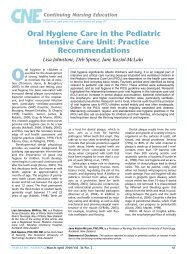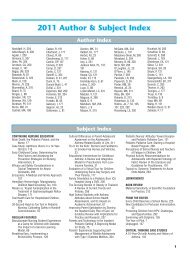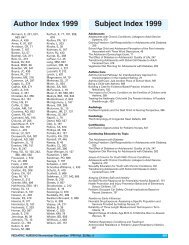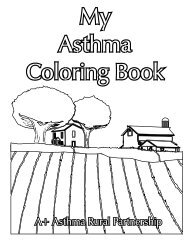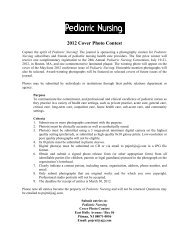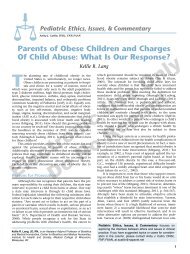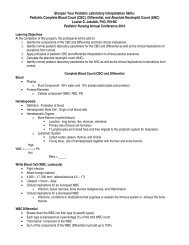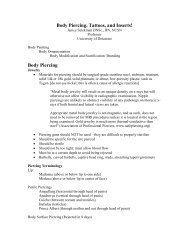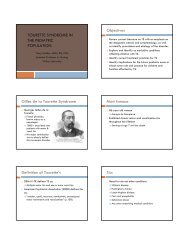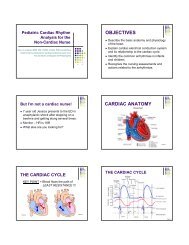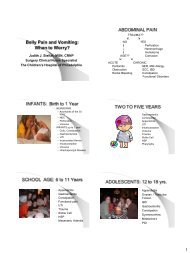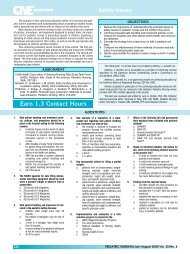Jannetti Publications Guidelines For Authors - Pediatric Nursing
Jannetti Publications Guidelines For Authors - Pediatric Nursing
Jannetti Publications Guidelines For Authors - Pediatric Nursing
Create successful ePaper yourself
Turn your PDF publications into a flip-book with our unique Google optimized e-Paper software.
12. PRODUCTION PROCESS<br />
a. After the final copyediting and review by the<br />
managing editor, the accepted manuscript is<br />
formatted into page proofs. This version contains<br />
any tables, figures, graphics, or pictures<br />
and represents how the article will appear in<br />
the journal.<br />
b. Page proofs are then sent to the primary<br />
author, who is asked to review them for typographic<br />
errors only, to verify all references,<br />
and return within 48 hours of receipt. A delay<br />
in return of corrected proofs, unanswered<br />
queries, or return of incomplete material may<br />
result in publication of the article without corrections<br />
or may postpone publication.<br />
c. The approved page proofs are sent to the<br />
printer, who prepares a final copy (blueline).<br />
It is the responsibility of the editor and managing<br />
editor to give final approval of the blueline.<br />
d. The entire production process takes about 6<br />
weeks.<br />
13. AFTER PUBLICATION<br />
a. <strong>Authors</strong> who wish to purchase reprints of their<br />
articles can obtain information from the journal<br />
office in Pitman, NJ, at the time of publication.<br />
b. <strong>Authors</strong>’ honoraria, if applicable, will be<br />
mailed within 4 weeks of the date of publication.<br />
When there is more than one author, the<br />
check will be made payable to the primary<br />
author and sent to that individual — along with<br />
complimentary copies of the issue — for distribution<br />
to co-authors.<br />
c. The editors welcome all authors to consider<br />
<strong>Jannetti</strong> <strong>Publications</strong> in their future publishing<br />
efforts.<br />
14. MISCELLANEOUS INFORMATION<br />
REGARDING STYLE<br />
a. Do not use contractions, except in a direct<br />
quotation.<br />
b. Avoid jargon — Words and phrases such as<br />
“health care delivery system,” “nursing profession,”<br />
“impacted,” “interfaced,” and “public<br />
and private sector” are overused and<br />
should be avoided.<br />
c. American vs. British — There are often two<br />
acceptable spellings for a word (e.g., acknowledgment,<br />
acknowledgement; judgment, judgement).<br />
When in doubt, use the American version<br />
of the word, not the British. (American<br />
versions are in italics.)<br />
d. Accuracy — When submitting a manuscript,<br />
the responsibility for accuracy is<br />
the author’s, not the editor’s.<br />
e. Abbreviations — The same abbreviation can<br />
stand for several things. Do not assume readers<br />
know the meaning. The first use of the<br />
abbreviation in an article must be preceded<br />
by the complete term. <strong>For</strong> example: Health<br />
Care Financing Administration (HCFA).<br />
After that, the abbreviation can be used<br />
alone.<br />
f. The terminal -al can also be confusing — Is it<br />
psychological or psychologic? A general rule:<br />
Drop the -al unless dropping it changes the<br />
meaning. Example: “historical” cannot be<br />
changed to “historic” but “gynecological” can<br />
be changed to “gynecologic.” Another rule:<br />
If, without the terminal -al, a word has three<br />
or fewer syllables, then add it. This results in<br />
such words as: surgical, statistical, obstetrical,<br />
etc. However, with four or more syllables,<br />
omit the -al — anatomic, urologic, neurologic,<br />
etc.<br />
g. Due and Due to — The word “due” is an<br />
adjective and must modify a noun. (“He got<br />
his due desserts.”) However, when a sentence<br />
begins with “Due to …” the word is misused.<br />
Change the phrase to “Because of…” or “As<br />
a result of …” “Due to” can follow a “to be”<br />
verb, since it then acts as a predicate adjective.<br />
(“His death was due to complications<br />
from severe head injuries.”) The “to” is a<br />
preposition, belonging to its own prepositional<br />
phrase.<br />
h. Which vs. That — “That” is used to introduce<br />
a limiting or defining clause. “Which” is used<br />
to introduce a nondefining or parenthetical<br />
clause. If the clause could be omitted without<br />
leaving the noun it modified incomplete, or<br />
without materially altering the sense of what<br />
is being said, or if it could reasonably be<br />
enclosed in parentheses, it would be better<br />
introduced by “which;” otherwise, by “that.”<br />
<strong>For</strong> example: “The Hudson River, which<br />
flows west of Manhattan, is muddy.” (A nondefining<br />
clause; it could be omitted or parenthesized.)<br />
But: “The river that flows west of<br />
Manhattan is the Hudson.” (The clause<br />
6



